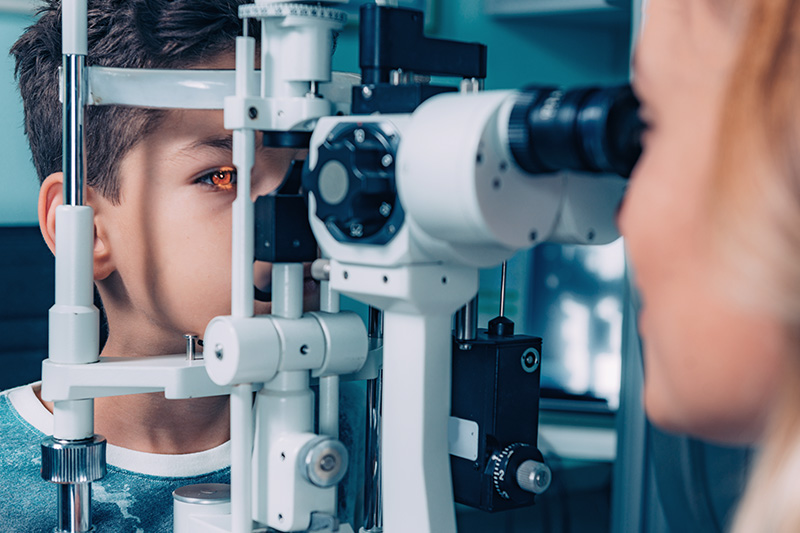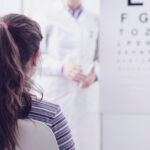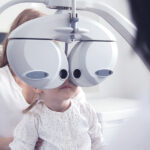Here’s how genetic vision testing can help your family

At least 600 of the roughly 20,000 genes in the human body are needed for normal eyesight. Changes in those genes can lead to many eye conditions, including glaucoma, cataracts, and inherited retinal disorders.
If your child has an inherited retinal disorder, they might benefit from genetic testing. It can help determine a diagnosis and how their vision could be affected over time. In some cases, it can even identify potential treatments. Boston Children’s ophthalmologists Dr. Anne Fulton and Dr. Pablo Altschwager, and pediatric geneticist Dr. Farrah Rajabi, explain how genetic testing could help your family.
What is genetic testing?
Genetic testing looks for changes, or variations, in your child’s DNA to determine if they have a genetic condition and whether it might affect other family members. It looks at the order of nucleotides — the building blocks of DNA and RNA — in a gene to see if it differs from what’s expected. The differences in the nucleotides are called variants. If a variant that is pathogenic is found on your child’s genetic test, that means it is causing the gene to be defective and is the cause for the retinal disease in your family.
How does my child benefit from genetic testing?
“When it comes to genetic testing, knowledge is power,” Dr. Fulton says. “If we know which condition to watch for, we can monitor it closely if it’s not progressing. If it is progressing, we can start gene therapy treatment if it is available, and if not, we can help manage the condition.” The sooner gene therapy starts, the better. That’s because if too many cells diminish over time, treatment is usually less effective.
The testing narrows the findings of other diagnostic tools, such as an electroretinogram (ERG). For instance, while an examination can detect typical symptoms of an inherited retinal disease, genetic testing can confirm or get closer to a diagnosis and open the door to targeted treatment, which could include an FDA-approved gene therapy or a clinical trial for another type of gene therapy. Gene therapy will work only if clinicians know which gene needs to be treated. “The understanding we get from genetic testing lets us consider all the factors that will determine how we will care for a patient,” Dr. Altschwager says. Also, genetic testing can connect diagnostic dots and indicate when a condition might affect other parts of the body, requiring specialists from other medical disciplines.
How will my family also benefit?
Genetic testing can also guide the testing of family members, including other children, to identify those at risk for the same condition. Most vision conditions are not detected with standard prenatal genetic testing, Dr. Rajabi says, so many parents do not know they carry pathogenic variants that put their families at risk for retinal disorders.
Should my child undergo genetic vision testing?
We recommend that anyone with a family history of a genetic disorder or who has symptoms that are diagnosed or observed after an eye examination be tested.

What should we expect?
Before a test, a geneticist will review your child’s medical history, family history, or both. They’ll either draw blood or swab the inside of your child’s cheek to collect a DNA sample. The genetic testing lab will take several months to test the sample.
What kind of results can you expect from a genetic test?
- Pathogenic variant: The gene has a variant that makes it not work, causing symptoms. Sometimes, geneticists can get an idea of future symptoms based on the genetic variant.
- Variant of uncertain significance: The gene has a variant but not enough is known about it to provide a diagnosis and determine how it could affect health. Expanding testing to family members may help get a result.
- Normal result with no genetic diagnosis: Sometimes, genetic testing does not reveal the defective gene. This doesn’t mean the condition is not genetic, but it may be related to a gene that cannot be easily tested or one that is not yet known. Larger genetic testing (exome sequencing or genome sequencing) could help if the first test does not provide an answer. Testing can also be repeated in the future, when technology and knowledge are improved.
What is retinal gene therapy?
Gene therapy works by replacing a defective gene with a healthy copy of that gene. Only one type of retinal gene therapy — Luxturna™ — is currently approved by the FDA. It’s for people who have two copies of a known variant in the RPE65 gene, what is known as confirmed biallelic RPE65 retinal disease. Patients with biallelic variants in RPE65 often have a clinical diagnosis of the inherited retinal disorders Leber congenital amaurosis (LCA) or retinitis pigmentosa (RP).
With gene therapy, a working copy of the RPE65 gene is injected beneath the retina so it can be absorbed by retinal cells. The newly restored cells are then able to make the actual RPE65 protein. If successful, eyesight is restored. Light in the eye can again be converted to electrical signals and interpreted by the brain.
What if my child isn’t eligible for gene therapy?
Because FDA-approved gene therapy is limited, many retinal diseases can’t be treated. Unfortunately, there are no cures for most IRDs.
But there’s hope: Many clinical trials for gene therapy treatments are in progress and new treatments continue to be developed in labs. In the meantime, your child can receive help through a variety of resources — including low vision devices — and services such as teachers who are specially trained to help children with vision problems learn.
Learn more about the Department of Ophthalmology.
Related Posts :
-

Pioneering trial offers hope for late treatment of ‘lazy eye’
In children with amblyopia or “lazy eye,” one eye is weaker than the other for any of a number of ...
-

Help your child prevent myopia with two simple steps
Myopia — also known as nearsightedness, or the inability to see things far away — is becoming more prevalent in ...
-

Get a jump on potential eye conditions by having your child regularly tested
It can be surprising to learn your child has an eye condition. Children don’t always outwardly show symptoms of ...
-

All eyes on retinoblastoma: How Lyla and her mom are helping change lives
Meghan Landry firmly believes that art saved her daughter Lyla’s life. Now, she hopes to leverage the power of ...





